-

人教版高中历史必修3辉煌灿烂的文学说课稿
教师:不同的时代造就了不同风格和不同精神内容的诗词,请同学们回顾必修一和必修二两宋中央集权的加强和经济的发展状况。学生:回忆回答。教师:请同学们结合时代背景和词的特点理解词为什么能够成为宋代文学的主流形式和标志?学生:两宋时经济重心转移到了南方,商业发展打破了时间和空间的限制,城市繁荣,市民数量不断增加。词的句子长短不齐,便于抒发感情,并且能够歌唱,更能适应市井生活的需要。于是,词成为宋代文学的主流形式和标志。教师:宋代文人地位提高,宋词就是一个个时代的画卷:大宋的悲欢离合都写在了里面。除了词之外,宋代民间还兴起了一种新的诗歌形式,即散曲。学生:回答散曲的发展阶段及特点、元曲的含义、特点。教师:在中国古代诗歌辉煌发展的同时,也产生了供人们闲来无事消遣的小说。
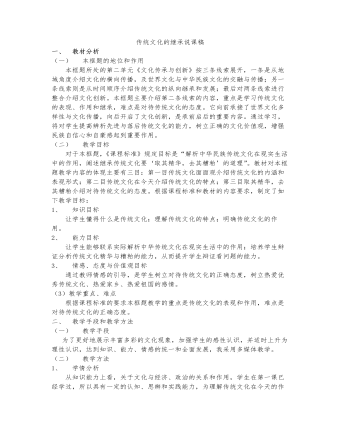
人教版高中政治必修3传统文化的继承说课稿
只有对儒家的价值作出客观、公正、全面的评价,才可能避免陷入文化虚无主义或文化复古主义的误区,合理地、充分地开发利用儒学乃至整个国学的资源为现代社会服务,为促进我国经济发展服务。运用所学知识,谈谈对待儒学我们应该持有的态度。答案:(1)儒学是我国传统文化中一个非常重要的组成部分。传统文化具有相对稳定性,它的内涵又能够因时而变,因此,我们对待儒学的正确态度应该是“取其精华,去其糟粕,批判继承,古为今用”。(2)面对儒学,我们要辩证地认识它在现实生活中的作用,分辨其中的精华和糟粕。对于其中符合社会发展要求的、积极向上的内容,应该继续保持和发扬,使其为社会主义现代化建设服务;对于其中不符合社会发展要求的、落后的、腐朽的东西,必须“移风易俗”,自觉地加以改造和剔除。(五)作业布置传统文化的作用是什么?如何正确对待传统文化?

人教版高中政治必修3感受文化影响说课稿
(2)世界观,人生观,价值观是人们文化素养的核心和标志。一旦形成就会对人产生深远持久的影响。(但随着生活阅历的变化,人们文化素养的提高,人们的“三观”会发生变化。)总之“潜移默化”指每时每刻,不知不觉;是从文化对人影响的过程来看的。“深远持久”指经年累月,难以抹去;是从文化对人影响的结果上说的。3.课堂总结:首先启动学生思维,教会学生把握知识主线,建构知识体系,先由学生进行总结,然后教师进行必要的补充4、布置作业:布置作业。运用文化对人的影响的知识分析“近朱者赤,近墨者黑”,并且应该如何处理朋友之间的关系。设计这个作业的意图是既让学生灵活运用所学知识,同时又让学生回归生活,如何处理朋友之间的关系。5、板书设计遵循板书设计的实用性、直观性的原则,根据本课的教材特点,我采用结构式板书,这样设计比较直观、系统,以便于学生能够系统把握和理解知识。
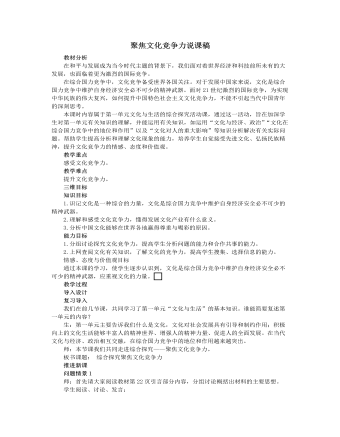
人教版高中政治必修3聚焦文化竞争力说课稿
(1)文化与经济、政治在经济基础上相互影响。①经济、政治和文化是社会生活的三个基本领域。其中,经济是基础,政治是经济的集中表现,文化是经济和政治的反映。一定的文化由一定的经济、政治所决定,又反作用于一定的政治、经济,给予政治、经济以重大影响。②经济发展是文化发展的基础。但这并不意味着文化的发展始终与经济的发展亦步亦趋。如同不能简单地把精神文明看作是物质文明的派生物和附属品一样,也不能简单地认为文化是经济、政治的派生物和附属品。文化有其自身的传承性和相对的独立性。那种认为只要物质条件好了,精神文化自然而然地就会好起来,物质条件差一点,精神文化就不可能搞好的观点,不符合历史发展的事实,是不正确的。③掀开历史的画卷,文化既有古今和地域之别,又有先进与落后、腐朽之分。不同的文化,对经济、政治的影响不同,对社会发展的作用也不同。不同民族的文化,影响不同民族和国家各具特色的发展道路。
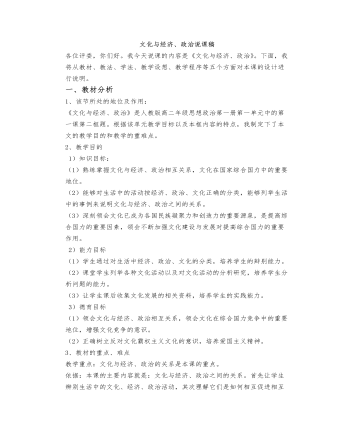
人教版高中政治必修3文化与经济、政治说课稿
(二)讲授新课:1、讲授重点:文化与经济、政治的关系。我首先带领学生分析课本上的活动探究,了解日常生活中的常见活动,让学生们观看视频材料帮助学生对文化活动、经济活动、政治活动进行辨别和分类。然后让学生们举例说明,综合探究,最后通过集体讨论得出文化与经济政治的关系:经济是基础,政治是经济的集中表现,文化是经济和政治的反映,一定的文化由一定的经济和政治决定,又反作用于政治和经济。这个问题是本课重点。要引导学生循序渐进,集体讨论,得出结论。2、突破难点:(1)文化与经济政治相互交融,在时代发展的进程中。首先播放上海世博会视频,让学生体会文化、经济、政治活动,另外我会引导学生积极举生活中的事例,来说明问题,让学生学会举一反三,充分理解这一知识,让学生明白文化与经济、政治的联系,让学生清楚文化渗透的力量有多大,帮助学生树立反对文化霸权主义的意识。
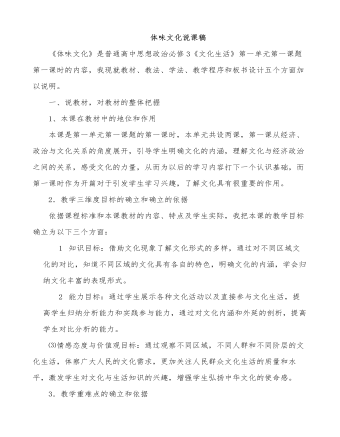
人教版高中政治必修3体味文化说课稿
(二)引入内容1、播放幻灯片,从名言引出思考,什么是文化,如何理解文化?学生探究,既可质疑,也可谈自己对文化的理解2、幻灯片,以三组幻灯,分三个阶段,学生分别通过小组讨论的形式,归纳总结文化现象的三个特征3、根据对文化现象的认识,归纳总结文化的内涵及外延小活动:把不是文化的山、水、树,由几组同学画出来,体会文化的含义4、一组判断题,哪些是文化的,哪些不是5、理解文化的特点首先,根据前面,总结文化现象的特征,归纳出文化的普通性及特殊性其次,播放视频,归纳总结文化是人类特有的现象第三,根据教材材料,小组探究总结,文化是后天习得的第四,借助小活动的材料,归纳,文化需要一定的物质载体6、文化的作用首先、观看视频,小组探究总结,文化对于人的影响其次,观看视频,小组探究总结,文化对社会的影响
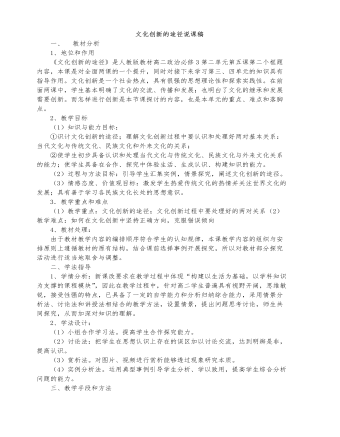
人教版高中政治必修3文化创新的途径说课稿
一、 教材分析1、地位和作用《文化创新的途径》是人教版教材高二政治必修3第二单元第五课第二个框题内容,本课是对全面两课的一个提升,同时对接下来学习第三、四单元的知识具有指导作用。文化创新是一个社会热点,具有很强的思想理论性和探索实践性。在前面两课中,学生基本明确了文化的交流、传播和发展;也明白了文化的继承和发展需要创新。而怎样进行创新是本节课探讨的内容,也是本单元的重点、难点和落脚点。2、教学目标(1)知识与能力目标:①识计文化创新的途径;理解文化创新过程中要认识和处理好两对基本关系:当代文化与传统文化、民族文化和外来文化的关系;②使学生初步具备认识和处理当代文化与传统文化、民族文化与外来文化关系的能力;使学生具备在合作、探究中体验生活、生成认识、构建知识的能力。
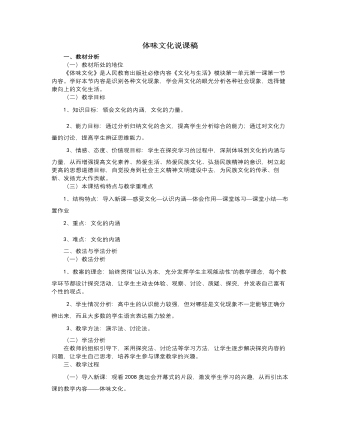
人教版高中政治必修3体味文化说课稿
3、文化的力量。为了使学生能辨证地分析文化的力量,我设计了两个问题进行探讨:(1)是不是任何文化都能起促进作用?(2)你在听或唱国歌时感受到一种什么样的力量?这样,学生在对比中学会辨证地分析文化的力量——先进的、健康的文化能促进社会发展和个人成长;落后的、腐朽的文化则阻碍社会发展和个人成长。同时还能提高学生的文化赏析能力,从而引导学生装自觉参加健康有益的文化活动,抵制不良文化的影响,投身到社会主义精神文明建设中去。关于课堂练习,我准备了5个针对性比较强的选择题,从而加深巩固本框题的重难点知识。最后,播放歌曲《走进新时代》,展示本课知识结构,指出本框题需重点掌握的问题,结束本课教学。课后作业,我设计了这样一个辨析的题目:文化是人们创造的全部财富的总和,它是人类特有的现象。
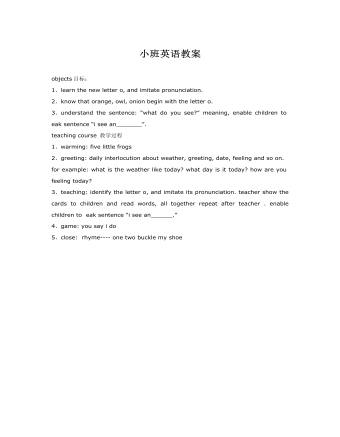
小班英语教案
objects目标: 1、learn the newletter o, and imitate pronunciation. 2、know that orange,owl, onion begin with the letter o. 3、understand thesentence: “what do you see?” meaning, enable children to eak sentence “isee an_______”. teaching course 教学过程 1、warming: fivelittle frogs
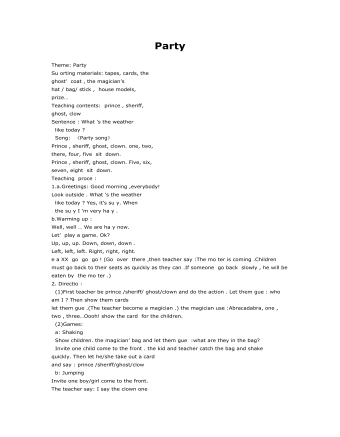
大班英语教案:Party
prize… Teaching contents: prince , sheriff, ghost, clow Sentence : What ’s the weather like today ? Song: 《Party song》 Prince , sheriff, ghost, clown. one, two, there, four, five sit down. Prince , sheriff, ghost, clown. Five, six, seven, eight sit down. Teaching proce : 1.a.Greetings: Good morning ,everybody!
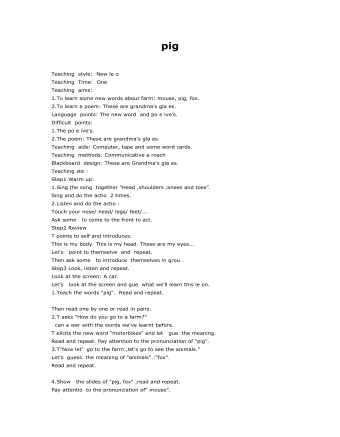
大班英语教案:pig
1.To learn some new words about farm: mouse, pig, fox. 2.To learn a poem: These are grandma's glaes. Language points: The new word and po eive's. Difficult points: 1.The po e ive's. 2.The poem: These are grandma's gla es. Teaching aids: Computer, tape and some wordcards. Teaching methods: Communicative aroach Blackboard design: These are Grandma's glaes. Teaching ste : Step1 Warm up: 1.Sing the song together "Head,shoulders ,knees and toes". Sing and do the actio 2 times.
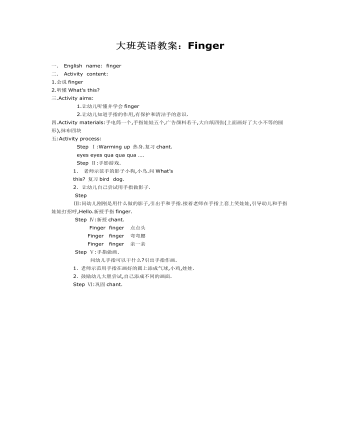
大班英语教案:Finger
二. Activity content:1.会说finger2.听懂What’s this?三.Activity aims: 1.让幼儿听懂并学会finger 2.让幼儿知道手指的作用,有保护和清洁手的意识.四.Activity materials:手电筒一个,手指娃娃五个,广告颜料若干,大白纸四张(上面画好了大小不等的圆形),抹布四块
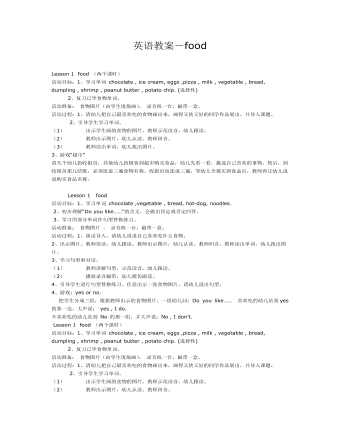
英语教案-food
2、复习已学食物单词。活动准备: 食物图片(由学生现场画)。 录音机一台,磁带一盒。活动过程:1、请幼儿把自己最喜欢吃的食物画出来,画得又快又好的同学作品展出,并导入课题。 2、引导学生学习单词。(1) 出示学生画的食物的图片,教师示范读音,幼儿跟读。(2) 教师出示图片,幼儿认读。教师纠音。(3) 教师读出单词,幼儿找出图片。3、游戏“超市”请几个幼儿扮收银员,其他幼儿扮顾客到超市购买食品,幼儿先看一看,挑选自己喜欢的事物,然后,到收银员那儿结账,必须连说三遍食物名称,收银员也连说三遍。等幼儿全都买到食品后,教师再让幼儿说说购买食品名称。 Lesson 1 food活动目标:1、学习单词 chocolate ,vegetable , bread, hot-dog, noodles. 2、初步理解“Doyou like……”的含义,会做出肯定或否定回答。 3、学习用部分单词作句型替换练习。活动准备: 食物图片 。 录音机一台,磁带一盒。活动过程:1、谈话导入。请幼儿说说自己喜欢吃什么食物。2、出示图片。教师范读,幼儿跟读。教师出示图片,幼儿认读。教师纠音。教师读出单词,幼儿找出图片。3、学习句型和对话。 (1) 教师讲解句型,示范读音,幼儿跟读。(2) 播放录音磁带,幼儿模仿跟读。4、引导学生进行句型替换练习。任意出示一张食物图片,请幼儿说出句型。

幼儿英语教案
2.句型whereto? go to…… 活动目标:1.幼儿能初步掌握单词发音。 2.能正确理解句型含义。 3.踊跃地参加游戏,大胆大声练读。 活动准备:1.挂图[park zoo hospital postoffice] 2.卡片[park zoo hospital postoffice] 3.长绳5条。 重难点:1.post office的发音。 2.句型的理解。 活动过程:一.开始部分 1. 操练单词:出示挂图 T: what s this? C: park. T: what s this? C: zoo. [新单词] 出示挂图 T:有一个人告诉你他生病,你应该告诉他上哪去呀?

人教版高中英语必修2Computers说课稿3篇
一. 教材分析1. 本单元的中心话题是“计算机(Computers)”,内容涉及计算机的发展历史,计算机的应用等。本节课是该单元的第一课时,我将Warming up, Pre-reading and Comprehending这四部分整合为一节精读课。其中。Reading部分是题为WHO AM I?的文章,以第一人称的拟人手法介绍了计算机发长演变的历史和计算机在各个领域的应用,其主旨是表达计算机的发展变化之快以及在生活中用途之广。而Warming up部分以图片的形式展现了计算机的发展历程;Pre-reading中的问题和排序分别是为了预测语篇的内容和测试学生对计算机历史了解的情况;Comprehending则通过各项练习训练学生的阅读技能,从而加深对文章的理解。可见这几部分是一个有机的整体。2. 教学目标:1) 语言目标:重点词汇及短语:abacus, calculate, calculator, PC, laptop, PDA, robot, analytical, technological, universal, mathematical, artificial, intelligent, network, explore, in common, as a result.重点句子:a. My real father was Alan Turing, who in 1963 wrote a book to describe how computers could be made to work, and build a “universal machine” to solve any mathematical problem.

人教版高中英语必修4A taste of English Humor说课稿3篇
Then I would ask them to think of a funny English or Chinese and tell it to partners. While telling stories, they can use expressions and some acting to help make the story funny. 5 minutes would be given to do this.Those stories they told there will be the material for their writing. Soletting them tell it at first is helpful. And they can make a difference between telling a funny story and writing it down. Generally speaking, it is difficult forstudents to write well because they don’t know what to write and how to write. Asking them to tell their own stories at first can help them come up with what to write.After their telling, I would invite someone to share his/her story with all of us and I would write it down on the blackboard.This example story would be used as a sample to illustrate the format of funny story. Different from a story from teacher or textbook, a story from students can obviously become a interesting material to draw students’ attention.Then I would ask the whole class to put this story into several parts. It might be a little bit difficult for them. So I would ask them to find out whether all the sentences are necessary. After delete some sentences, there are 6 sentences left behind. Then they can easily put them into three parts. After interaction with students, I would teach them the right terms for each part and conclude the format of funny story.This step is the key and difficult point in my lesson. So I mainly usetask-based teaching method in this part and the task for students was divided into several stages. With the separated difficult level, students can find there are usually three parts in writing. They can also learn to write without the unnecessary parts in the process of analyzing. And then I wouldn’t rush to tell them the right terms to them directly. Instead, I would ask them to name them by their own. A confused mind is better for acquiring knowledge.While-writing:Then I would give students 7 minutes to write down this story, without other requirements.With all the preparations in pre-writing, students’ difficulties were cleared. So it would be much easier for them to write down the story within 7 minutes. There are no other requirements because students’ first writing is actually a drafting. It would be revise and edit several times later. Writing, as a skill

人教版高中英语必修3Healthy Eating说课稿4篇
Language learning needs a context, which can help the learners to understand the language and then can product comprehensible output, so computer has the advantages to make the materials attractive.Part 3 Learning MethodsTask-based, self-dependent and cooperative learningPart 4 Teaching ProcedureStep One Lead-in“Interest is the best teacher.” Therefore, at the very beginning of the class, I should spark the students’ mind to focus on the centre topic “the band”. I’ll show some pictures of food to attract their attention and then bring some questions.Question:What kind of food they like?What should go into a good meal?The answers must relate to the diet. After this, the students will be eager to know something about a balance diet and this is the very time to naturally lead the class into Step 2Step 2 Reading for information: skimming and scanning In this step, I use Task-based Language Teaching method, which can give students a clear and specific purpose while skimming and scanning the context.Task 1 General ideaThe students will be asked to just glance at the title and the pictures of the passage, and then guess what they will read in the text. And they’ll be divided into groups of four to have a discussion.The purpose is to inspire the students to read actively, not passively. In addition, the task is to develop the students’ reading skill by making prediction and to encourage the students to express their thoughts in English and cooperate with each other.Task 2 Main idea of each paragraphCooperative learning can raise the students’ interest and create an atmosphere of achievement. Based on this theory, I divide the whole class into 4 groups to skim the whole text and get the main idea of each paragraph.

人教版高中英语必修5Life in the Future说课稿5篇
Good afternoon, everyone. It’s my great pleasure to be here sharing my lesson with you. The content of my lesson is Senior English for China Book5 Unit 3 Life in the Future. I’ll be ready to begin this lesson from six parts: Analysis of the teaching material, Analysis of the students, Teaching aims and important and difficult points, Teaching methods and aids, Teaching procedures, and Blackboard design. First, let me talk about the teaching material.Part 1 Analysis of the Teaching Material:This unit is about what human beings’ life will be like in about one thousand years. By studying of this unit, we’ll Enable the students to know the changes in humans’ life and some new inventions bringing about the change and develop the interest in science. This lesson plays an important part in the English teaching in this unit. This is an important lesson in Book Five. From this lesson, it starts asking the Ss to grasp contents of each passage. Therefore, this lesson is in the important position of the teaching material. If the Ss can learn it well, it will be helpful to make the Ss learn the rest of this unit.Part 2 Analysis of the SsAs Senior2 Ss, they are at different levels of English fluency, some of them have lost interest in English. So during the lesson, I arrange a variety of activities to let all of them join in to attract their interest and let them be confident and taste the joy of success.

人教版高中英语必修1Journey Down the Mekong说课稿
2. let the Ss complete the forms paragraph by paragraph. Purpose here is to help Ss to get the habit of reading a passage as a whole, and pay attention to the organization of the text, as a result the Ss will fully understand the whole passage.3. ask Ss to retell the passage with the help of the key words in the form.Since the Ss in the class are in different levels, so I let them to fill in the blank to understand the meaning of the words and phrases better. ( That’s all for the while-reading. Now let’s move to the fifth step.)Step V: Post-reading (10mins) ---DiscussionIn this part students are asked to discuss in groups and list Wang Kun’s and Wang Wei’s attitudes about the trip. After that, Ss are encouraged to express their attitudes with the whole class. Collect their answers and don’t forget to praise them even if their answers may not be perfect.In this activity, discussion provides a vivid and active learning environment for Ss to communicate in English with newly learned language items. (Finally it comes to the homework.)StepⅥ: Homework (1min)1. Ss are required to read the text again after class and figure out the meaning of some complex sentences.2. Do the exercises on P19; This can help Ss to consolidate what they’ve learnt and make preparation for the next lessonPart4. Blackboard design.(说板书设计)On the top, there is the title of this lesson. On the left, there are main ideas for each paragraph. On the right, there are some new words and expressions.Unit 3 Travel journalJourney down the MekongMain idea of each para.:Para1: deciding to take a great bike trip along the Mekong river.Para2: Different attitudes between Wang kun and Wang wei.

人教版高中英语必修4Body Language说课稿4篇
Textbook: Senior English for China (Book 4), by Liu Daoyi Time Allotment: 1 period (40 minutes)Date: March 20, 2014Teaching aids: blackboard, Multi-media, Power Point, chalk I. Text Analysis (教材分析)This unit is about body language, and the text selected in the reading part demonstrates the difference and similarity of body language in many parts of the world. Through learning this passage, students are required to raise their awareness of using body language in different parts of the world. As body language is closely related to our daily life, it is easy to arouse students’ interest in learning this text. Reading skills and speaking training are designed around the text.II. Teaching Objectives (教学目标)By the end of the lesson, students will be able to:1. Language Skill Objective(语言技能目标): develop reading ability (skimming and scanning)as well as speaking ability.2. Cultural Knowledge Objective(文化知识目标): know about the cultural differences of using body language.3. Affective Objective(情感目标): increase students’ awareness of using body language correctly in different cultures. III.Teaching Focuses and Difficulties(教学重点和难点)1. Teaching Focuses(教学重点): the difference and similarity of body language in many parts of the world.2. Teaching Difficulties(教学难点): develop students’ reading abilities of skimming and scanning and ask the students to show their opinions with fluent English.

